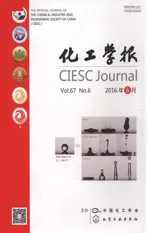孔密度对泡沫金属内湿空气的换热与压降特性影响分析
2016-07-07翁晓敏胡海涛赖展程庄大伟丁国良上海交通大学制冷与低温工程研究所上海200240
翁晓敏,胡海涛,赖展程,庄大伟,丁国良(上海交通大学制冷与低温工程研究所,上海 200240)
孔密度对泡沫金属内湿空气的换热与压降特性影响分析
翁晓敏,胡海涛,赖展程,庄大伟,丁国良
(上海交通大学制冷与低温工程研究所,上海 200240)
摘要:通过实验研究,得到不同孔密度的泡沫金属内湿空气的换热和压降特性,并对泡沫金属换热器综合性能进行了分析。测试样件为泡沫铜,孔密度为5~40 PPI(pores per inch),孔隙率为95%。研究结果表明,由于凝结水的存在,泡沫金属内的湿空气传热系数随着孔密度的增大先增大后减小,孔密度为15 PPI时达到最大值;压降随着孔密度的增大而增大,且大于20 PPI时压降增大更明显。综合考虑传热系数与压降因素,泡沫金属孔密度为15 PPI时综合性能最佳。
关键词:泡沫金属;孔密度;换热;压降;湿空气
2015-11-13收到初稿,2016-03-04收到修改稿。
联系人:胡海涛。第一作者:翁晓敏(1990—),女,硕士研究生。
Received date: 2015-11-13.
Foundation item: supported by the National Natural Science Foundation of China (51576122) and the Natural Science Foundation of Shanghai (15ZR1422000).
引 言
开孔泡沫金属具有多孔结构,其有较大的比表面积和热导率[1-2]、良好的流体扰流等性能,使其在紧凑式换热器上具有良好的应用前景[3]。与常规翅片相比,泡沫金属内析湿工况下的换热特性比翅片高67%~82%[4];因此,采用泡沫金属替代常规翅片,有望提高湿空气析湿工况下的换热特性。
泡沫金属结构的变化,导致泡沫金属上液滴的成核点[5]、比表面积和液滴在表面上的附着情况不同,从而影响湿空气析湿过程中的换热与压降特性。为了对泡沫金属换热器进行优化设计,必须了解泡沫金属结构对湿空气换热与压降特性的影响规律。
已有关于析湿工况下湿空气热质传递特性的研究,主要集中为翅片管换热器[6-7]。对于泡沫金属的研究,主要有泡沫金属表面上凝结液滴行为的数值模拟[8]和运行工况对热质传递特性影响的实验研究[4-5]。已有研究表明,随着湿度、温度和速度的增大,换热量和压降均增大,高PPI的泡沫金属增长更快[5]。到目前为止,没有关于湿空气下泡沫金属结构对换热和压降特性的影响研究报道。
已有关于泡沫金属结构对空气侧性能的影响,主要集中为干空气对流换热[9-11]。研究结果表明,干空气对流换热性能和压降随着泡沫金属孔密度和孔隙率的增大而增大[12-14]。在湿工况下,冷凝水会附着聚集在泡沫金属结构内[4-5],导致泡沫金属内热质传递特性与干工况存在很大差异。因此,需要对析湿工况下泡沫金属内的换热和压降特性开展实验研究。
本文的目的是通过实验研究,得出在湿工况下泡沫金属孔密度对换热和压降性能的影响规律,为换热器的设计提供参考。
1 实验装置及测试对象
实验系统包括空气侧系统、冷却水系统、测量数据采集系统,如图1所示。空气侧中,经过压缩不同湿度要求的比例混合成湿空气吹过测试样件。进口和出口的一些参数通过Aligent数据采集仪采集并记录。具体的实验装置介绍见文献[4-5]。
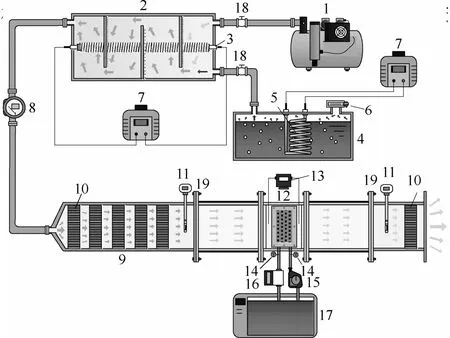
图1 实验装置Fig.1 Schematic diagram of experimental rig1—air compressor; 2—air condition box; 3—electrical heater for air; 4—humidifier; 5—electrical heater; 6—water filler; 7—power regulator; 8—volume flow meter; 9—visualization section; 10—air deflector; 11—temperature and humidity transducer; 12—test sample; 13—differential pressure transducer; 14—thermocouple; 15—micro water pump; 16—magnetic flow meter; 17—thermostatic water tank; 18—flow rate control valve; 19—connecting flange
测试样件为泡沫铜。不同的孔密度PPI的值分别为5、10、15、20、40。通过排水法测量样件的孔隙率,取样件孔隙率近似为95%的样件进行实验研究。样件如图2所示。
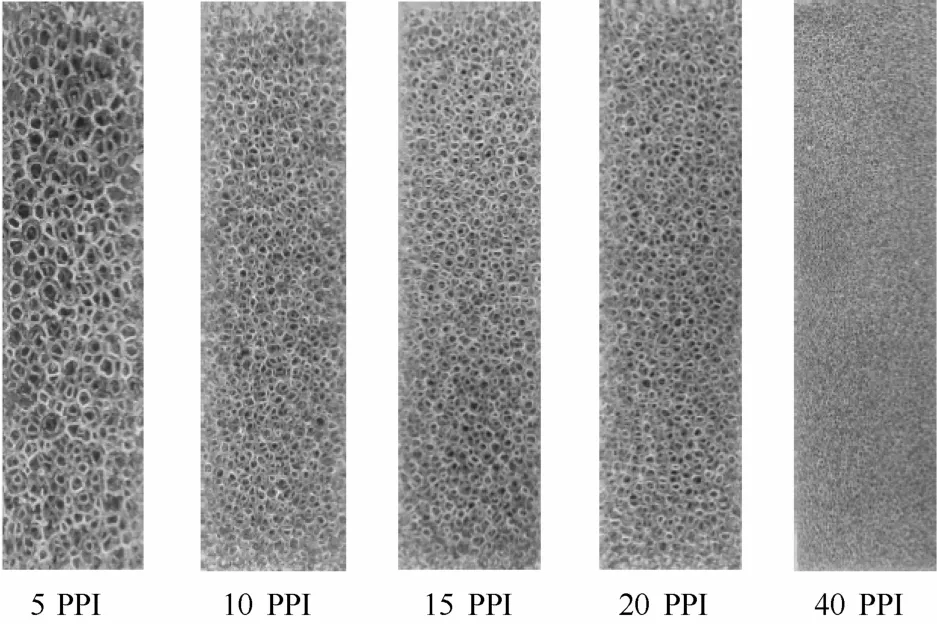
图2 实验样件Fig.2 Metal foam test samples
2 实验数据处理
湿空气在泡沫金属内的流动特性包括换热和压降两部分。其中压降通过样件两侧连接的压差传感器直接测得。换热需要通过测量进出口的温度、湿度、压力等参数进行求解。
换热器的换热量在数据处理中取空气侧换热量Qa与冷却水侧换热量Qw的平均值。

根据ASHRAE33—78[12]中的要求,有效数据必须满足|Qw−Q|/Q≤0.05。水侧换热和空气侧的换热公式可以参看文献[13]。空气侧的传热系数可以由式(2)得到,水侧的传热系数可由式(3)~式(5)得到[14-15]。
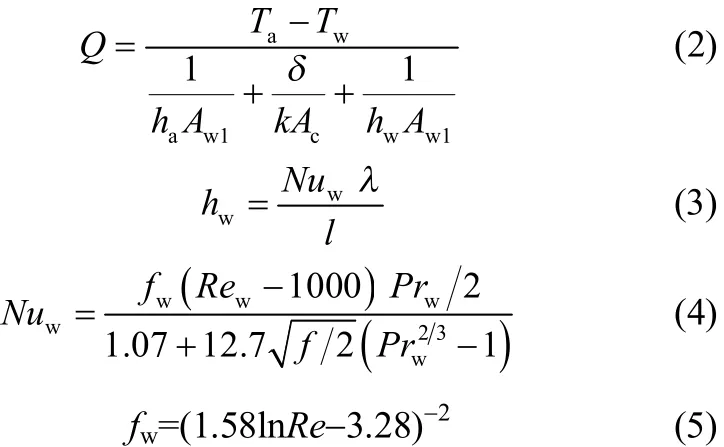
式中,Ta、Tw分别为空气侧和水侧的平均温度;ha、hw分别为空气侧和水侧的传热系数;k为铜板的热导率;δ为铜板厚度;Aw1、Ac、Aw2分别为空气侧的有效换热面积、铜板换热面积和水侧有效换热面积;Nuw为水侧的Nusselt数;λ为水侧的热导率;l为水侧的有效长度;fw为水侧的摩擦因子;Rew为Reynolds数;Prw为Prandtl数。
总的换热因子j和阻力因子f的计算公式如下
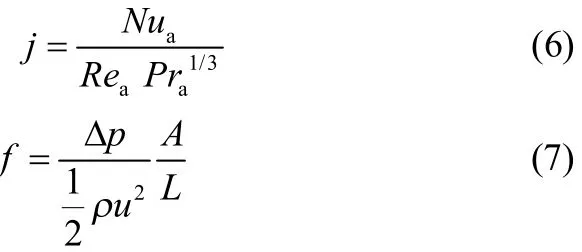
式中,Nua、Rea、Pra分别为空气侧Nusselt数、空气侧Reynolds数和空气侧Prandtl数;u为湿空气速度;ρ为湿空气密度;Δp为空气侧样件两端的压降;A为通道有效面积;L为样件有效长度。
根据实验直接测量参数的误差可以算出实验的间接测量的误差。由Moffat[16]方法分析得实验台的误差,换热量的误差为±13.5%,压差的误差为±3%[4]。
3 实验结果与分析
3.1不同湿度下PPI对换热和压降特性的影响
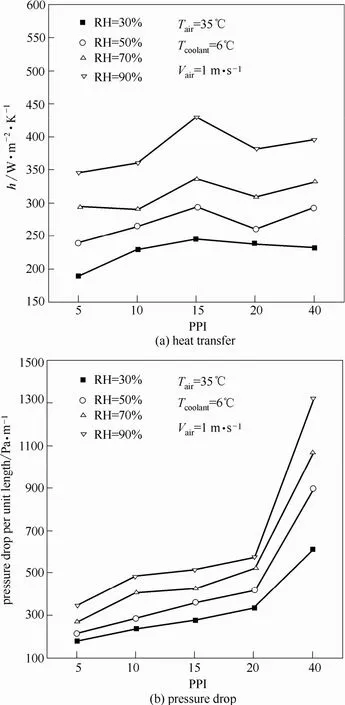
图3 不同湿度下PPI对换热和压降特性的影响Fig.3 Effect of PPI on heat transfer and pressure drop characteristics under different inlet air humidity conditions
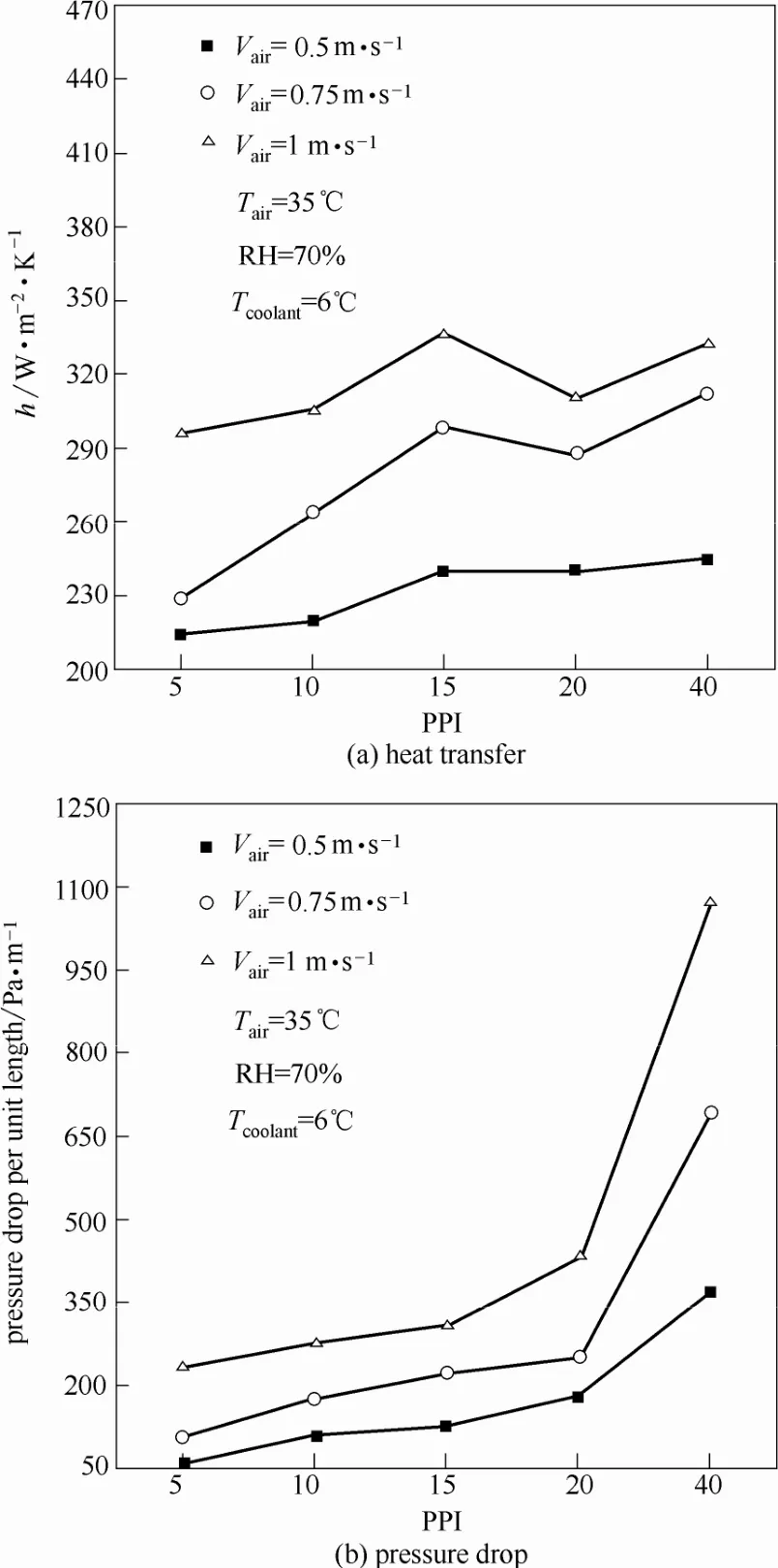
图4 不同速度下PPI对换热和压降特性的影响Fig.4 Effect of PPI on heat transfer and pressure drop characteristics under different inlet air velocity conditions
不同湿度下,湿空气传热系数和压降随PPI的变化关系如图3所示。从图3(a)中可知,随着PPI的增大,传热系数先增大后减小,15 PPI时达到最大值。表面粗糙度越大,结构越复杂,成核点越多,越有利于湿空气的凝结,产生较大的潜热换热[17]。但是孔径越小,越不利于冷凝水的排出,液滴的附着会抑制显热换热。因此,存在一个最佳PPI值,使得传热系数存在最大值。15 PPI的换热面积略小于20 PPI的换热面积,但是15 PPI具有较大的孔径,在湿度较大的情况下,潜热换热占主导地位,15 PPI泡沫铜的结构更有利于凝结水的不断生成和排出,使换热量和传热系数增大。
随着PPI的增大,泡沫金属纤维的结构变复杂,流动阻力随之增大,使压降变大。当PPI大于20时,压降随PPI的增长趋势更明显。
3.2不同速度下PPI对换热和压降特性的影响
不同流速下,湿空气传热系数和压降随PPI的变化关系如图4所示。从图4(a)可知,在析湿工况下,15 PPI具有较好的换热能力,流速越大,换热能力越好。由图4(b)可知,随着流速的增大,压降增大;且PPI为20时,压降随PPI增大急剧增大,增长速度明显高于低PPI情况。
3.3不同温度下PPI对换热和压降特性的影响
不同温度下,湿空气传热系数和压降随PPI的变化关系如图5所示。在不同进口温度下,15 PPI的换热能力最好,换热能力最大提高了25%~32%。随着空气进口温度的升高,空气与冷却水之间的温差增大,换热量增大;换热量的增大程度大于温差的增大,使得换热量和换热温差的比值增大,即传热系数增大。随着温度的上升,压降增大,温度对压降的影响相比于相对湿度、速度等其他因素最小。
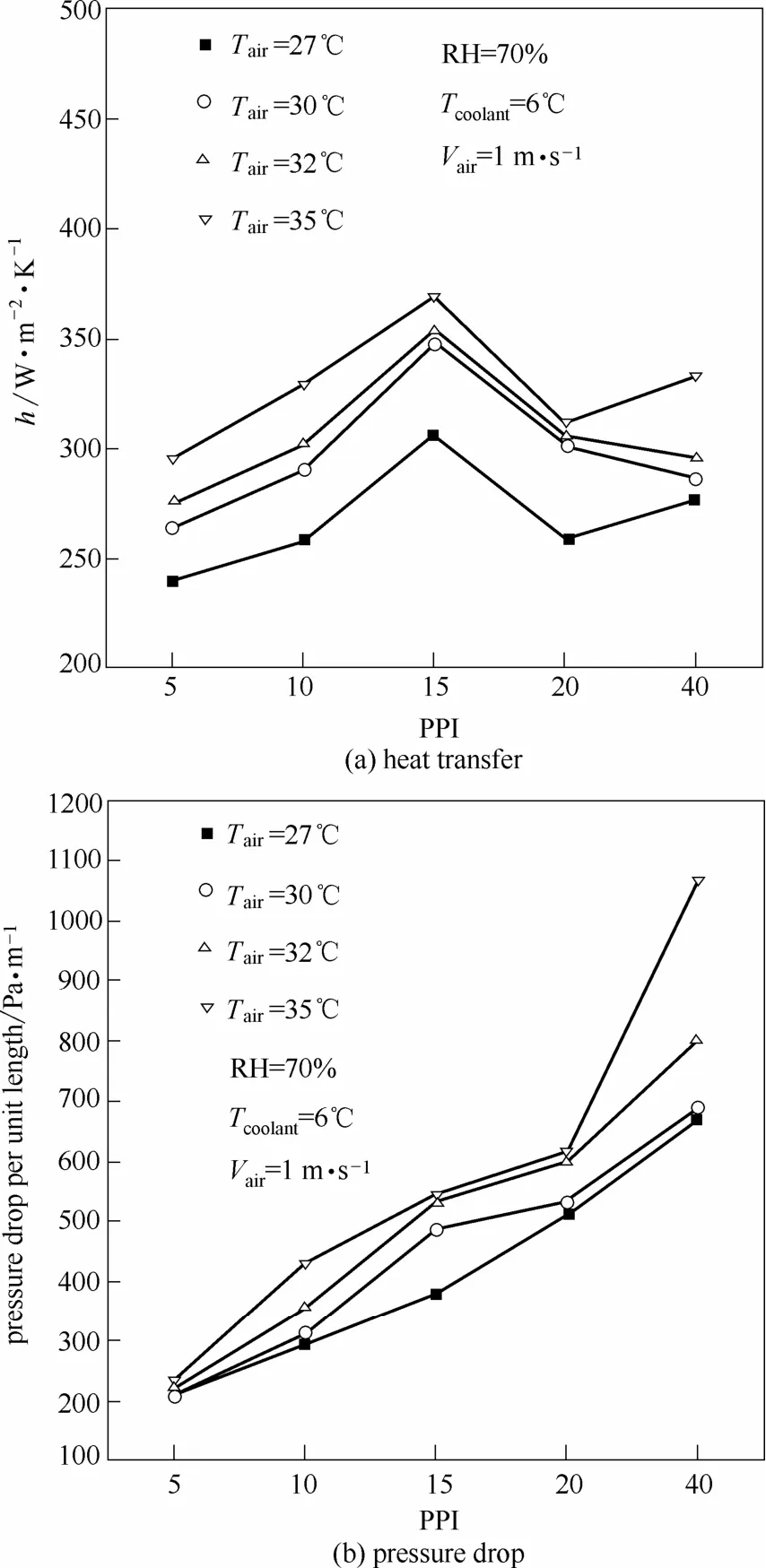
图5 不同温度下泡沫金属PPI对换热和压降特性的影响Fig.5 Effect of PPI on heat transfer and pressure drop characteristics under different inlet air temperature conditions
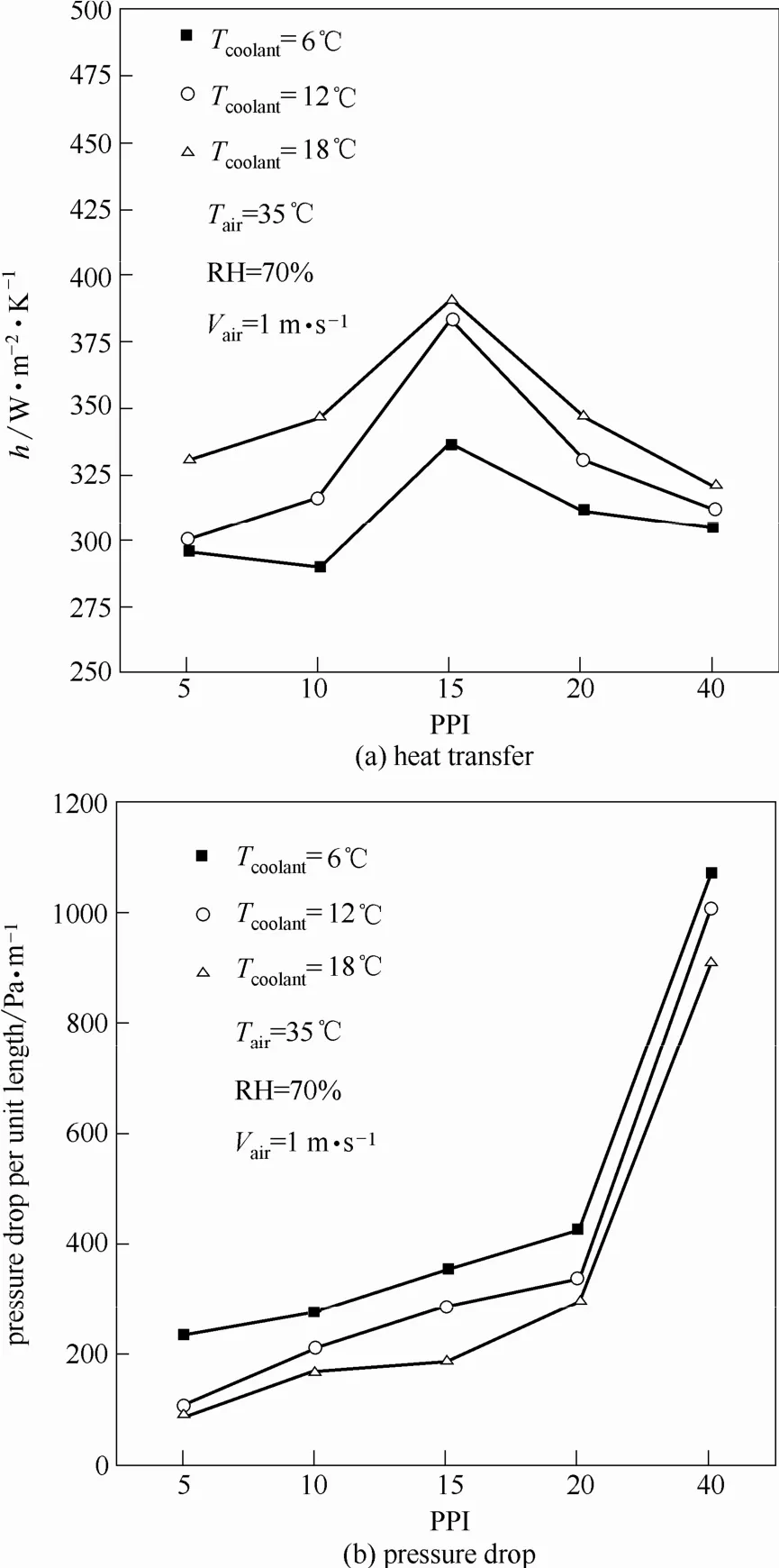
图6 不同冷却水温度下泡沫金属PPI对换热和压降特性的影响Fig.6 Effect of PPI on heat transfer and pressure drop characteristics under different water temperature conditions
3.4不同冷却水温度下PPI对换热和压降特性的影响
不同的冷却水温度下,湿空气在泡沫金属内的传热系数和压降随着PPI的变化如图6所示。冷却水温度越高,传热系数越大。这是由于冷却水温度高,湿空气与冷却水的温差变小,湿空气进出口温差变小,导致换热量减小;但是,湿空气与冷却水的温差减小量大于换热量的减小量,使得换热量和温度差的比值增大,即传热系数增大。
不同的冷却水温度下,随着PPI的增大,传热系数均呈现先增大后减小的趋势,在15 PPI处达到最大。15 PPI的传热系数比5 PPI的传热系数最大提高了27.5%,比40 PPI最大提高了22.7%。
3.5泡沫金属结构对析湿工况下综合性能的影响
基于热力学第二定律为基础的评价方法同时考虑热量传递的数量、质量和流阻3方面的因素[18]。本文采用j/f1/3作为综合性能评价指标,定性地判断在相同泵功条件下换热能力的增加是否大于阻力的增加[18]。通过对比不同PPI的能效指标,得到换热能效最佳的PPI值。
图7为不同湿度工况下,孔密度从5 PPI增大到40 PPI时j/f1/3综合性能评价指标的变化规律。从图7可知,随着湿度的提高,综合性能评价指标先增大后减小,在孔密度为15 PPI时达到最大。这是由于,15 PPI时传热系数达到最大,而压降小于20 PPI和40 PPI的压降。
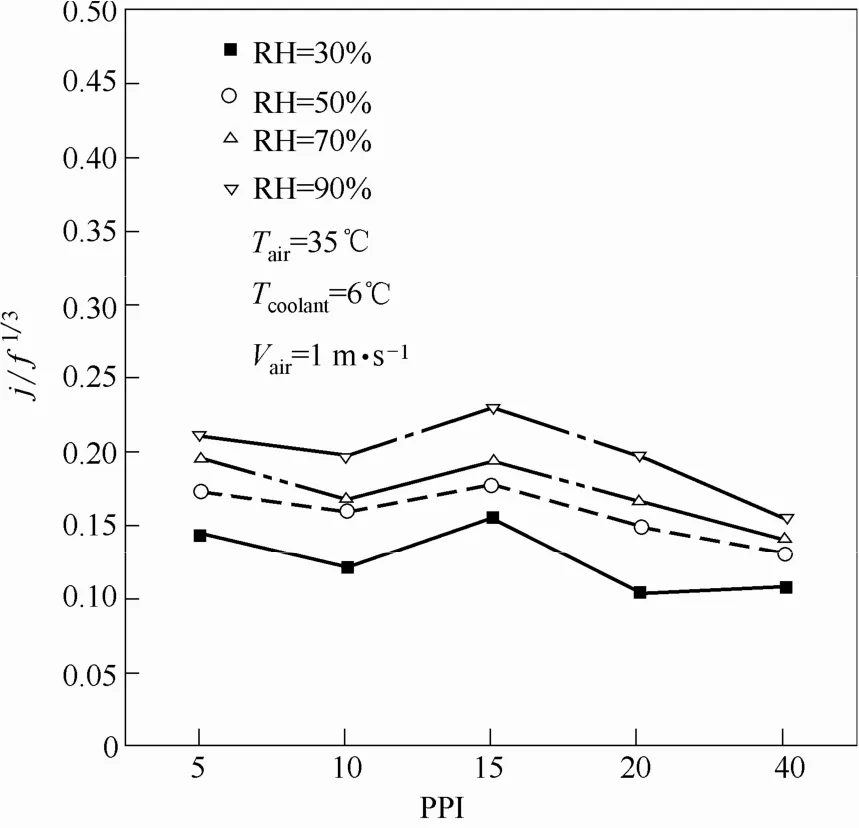
图7 不同湿度工况下泡沫金属综合性能评价Fig.7 Comprehensive performance evaluation of metal foam under different humidity conditions
4 结 论
本文针对孔密度为5~40 PPI的泡沫金属,在不同的湿度、温度、速度和冷却水温度条件下进行换热和压降的性能实验。结果表明,在不同湿度、温度、速度和冷却水温度的工况下,随着PPI的增大,传热系数先增大后减小,在15 PPI时传热系数最大;压降随着PPI的增大而增大。
采用j/f1/3综合性能评价指标对不同泡沫金属的结构在不同工况下进行评价。随着PPI的增大,综合性能评价指标先增大后减小,孔密度为15 PPI时,泡沫金属内析湿工况下的综合性能最佳。
符号说明
A——面积,m2
f——摩擦因子
h——传热系数,W·m−2·K−1
j——换热因子
k——热导率,W·m−1·K−1
Nu——Nusselt数
Re——Reynolds数
PPI——孔密度
Pr——Prandtl数
Q——换热量,W
T——温度,K
u——速度,m·s−1
δ——铜板厚,m
λ——水侧的热导率,W·m−1·K−1
ρ——密度,kg·m−3
下角标
a——空气(气相)
c——铜板
w——水侧(液相)
References
[1]DE SCHAMPHELEIRE S, DE JAEGER P, HUISSEUNE H, et al. Thermal hydraulic performance of 10 PPI aluminium foam as alternative for louvered fins in an HVAC heat exchanger [J]. Applied Thermal Engineering, 2013, 51(1): 371-382.
[2]CALMIDI V V, MAHAJAN R L. Forced convection in high porosity metal foams [J]. Heat Transfer, 2000, 122: 557-565.
[3]BOOMSMA K, POULIKAKOS D. On the effective thermal conductivity of a three dimensionally structured fluid saturated metal foam [J]. Heat and Mass Transfer, 2001, 44: 827-836.
[4]翁晓敏, 胡海涛, 庄大伟, 等. 湿空气在泡沫金属内析湿过程的换热与压降特性影响因素分析[J]. 化工学报, 2015, 66(5): 1649-1655. WENG X M, HU H T, ZHUANG D W, et al. Analysis of influence factors for heat transfer and pressure drop characteristics of moist air in metal foams during dehumidifying process [J]. CIESC Journal,2015, 66(5): 1649-1655
[5]HU H T, WENG X M, ZHUANG D W, et al. Heat transfer and pressure drop characteristics of wet air flow in metal foam under dehumidifying conditions [J]. Applied Thermal Engineering, 2016, 93: 1124-1134.
[6]WANG C C, DU Y J, CHANG Y J, et al. Airside performance of herringbone fin-and-tube heat exchangers in wet conditions [J]. The Canadian Journal of Chemical Engineering, 1999, 77(6): 1225-1230.
[7]LIN Y T, HWANG Y M, WANG C C. Performance of the herringbone wavy fin under dehumidifying conditions [J]. International Journal of Heat and Mass Transfer, 2002, 45(25): 5035-5044.
[8]PIROMPUGD W, WONGWISES S, WANG C C. Simultaneous heat and mass transfer characteristics for wavy fin-and-tube heat exchangers under dehumidifying conditions [J]. Heat Mass Transfer, 2006, 49(1/2): 132-143.
[9]MANCIN C, ZILIO A, DIANI L, et al. Experimental air heat transfer and pressure drop through copper foams [J]. Experimental Thermal and Fluid Science, 2012, 36: 224-232.
[10]MANCIN C, ZILIO A, DIANI L, et al. Air forced convection through metal foams: experimental results and modelling [J]. International Journal of Heat and Mass Transfer, 2013, 62: 112-123.
[11]DUKAN N, BAĞCI Ö, ÖZDEMIR M. Thermal development in open-cell metal foam: an experiment with constant wall heat flux [J]. International Journal of Heat and Mass Transfer, 2015, 85: 852-859.
[12]Method of testing forced circulation air cooling and air heating coils: ASHRAE 33-78 [S]. Atlanta, GA: American Society of Heating, Refrigerating and Air-Conditioning Engineers, Inc., 1978.
[13]YU R, SOMMERS A D, OKAMOTO N C. Effect of a micro-grooved fin surface design on the air-side thermal-hydraulic performance of a plain fin-and-tube heat exchanger [J]. International Journal of Refrigeration, 2013, 36(3): 1078-1089.
[14]COLEBROOK C F. Turbulent flow in pipes, with particular reference to the transition region between the smooth and rough pipe laws [J]. Journal of the Institution of Civil Engineers, 1939, 11(4): 133-156. DOI: 10.1680/ijoti.1939.13150.
[15]GNIELINSKI V. New equations for heat and mass-transfer in turbulent pipe and channel flow [J]. International Chemical Engineering, 1976, 16(2): 359-368.
[16]MOFFAT R J. Describing the uncertainties in experimental results [J]. Experimental Thermal and Fluid Science, 1998, 1(1): 3-17.
[17]MU C, PANG J, LU Q, et al. Effects of surface topography of material on nucleation site density of dropwise condensation [J]. Chemical Engineering Science, 2008, 63(4): 874-880.
[18]秦秋星, 李维. 换热器能效评定统一标准评价指标的研究[J]. 数字石油和化工, 2009, (5): 4448. QIN Q X, LI W. Research on efficiency evaluation standard of heat exchanger [J]. Digital Petroleum and Chemical, 2009, (5): 4448.
Analysis of influence of pore density on heat transfer and pressure drop characteristics of wet air in metal foams
WENG Xiaomin, HU Haitao, LAI Zhancheng, ZHUANG Dawei, DING Guoliang
(Institute of Refrigeration & Cryogenics Engineering, Shanghai Jiao Tong University, Shanghai 200240, China)
Abstract:The heat transfer and pressure drop characteristics of wet air in metal foams with different pore density were experimentally investigated, and the comprehensive performance of metal foam heat exchangers was analyzed. The test sample is copper foam, the PPI value of the tested metal foam covers 5—40 and the porosity is 95%. The results showed that the heat transfer coefficient increased initially and then decreased with the increase of PPI values due to the presence of the condense water. It reached up to the maximum value as the pore density was 15 PPI. The pressure drop increased with increasing pore density and the increment was more obvious as PPI value was higher than 20. The comprehensive performance was the best for the metal foam with 15 PPI by considering both the heat transfer coefficient and pressure drop.
Key words:metal foam; pore density; heat transfer; pressure drop; wet air
中图分类号:TK 124
文献标志码:A
文章编号:0438—1157(2016)06—2218—06
DOI:10.11949/j.issn.0438-1157.20151712
基金项目:国家自然科学基金项目(51576122);上海市自然科学基金项目(15ZR1422000)。
Corresponding author:HU Haitao, huhaitao2001@sjtu.edu.cn
